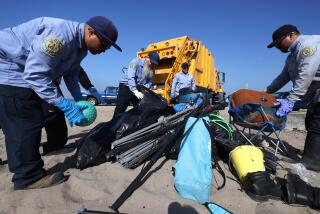Union Station: No stop for the homeless?
The new pilot program at Union Station that forbids people who are not holding train tickets to sit in the waiting room seats is another sad reminder of the city’s desperate homelessness problem — and of how difficult it is to balance the rights of Los Angeles’ most vulnerable citizens with the rights of others to go about their business safely and without fear or harassment.
The pilot program was instituted this month by the Metropolitan Transportation Authority because, MTA officials say, about 135 homeless people a night were descending on the station, intimidating travelers with aggressive panhandling, taking over the bathrooms and sprawling across seats. Officials said they were worried about a public health hazard because the homeless might be carrying bedbugs or have scabies.
They are right to be concerned: Union Station is a working train station. It is a public place, but it is also a building where business must get done, where travelers get their first view of Los Angeles, where Angelenos eat meals and commuters transfer to the Metro. It is not a homeless shelter and shouldn’t be turned into one.
YEAR IN REVIEW: Washington’s 5 biggest ‘fails’ of 2013
On the other hand, the homeless are not there for the fun of intimidating people or to spoil visitors’ impressions of the elegant and historic building. They are there because it is cold outside, because Union Station has a roof and does not charge admission or screen entrants. And they are there are because there are not enough shelter beds or supportive housing for the homeless in Los Angeles. There are more than 57,000 homeless men, women, and children in Los Angeles County. There are only slightly more than 4,000 shelter beds available each night.
The debate over Union Station’s homeless is only a small piece of a much bigger, long-running discussion. May the homeless sleep on the sidewalks of skid row without being rousted by police? May they sleep in their cars? Can they be fed on a street in a neighborhood in West Hollywood if residents object, or wander at night on the Venice boardwalk? These are questions that will not go away until society addresses the underlying issues of housing and poverty and substance abuse and mental illness that are at the root of homelessness.
In the meantime, Union Station cannot function as both a train station and a homeless encampment. For now, compassion should be the guiding rule in encouraging the homeless to leave the station. The Los Angeles Homeless Services Authority, the city-county agency that coordinates programs and funding for the homeless, says it sends an emergency response team to Union Station about three times a week in response to calls. Last week, its outreach workers were there on five days. The authority should keep up that pace during the colder months, perhaps even going out every day, encouraging the homeless to go to a shelter or seek medical help and offering transportation to get them there. This won’t solve homelessness in Los Angeles, but it might help alleviate the problem at Union Station.
More to Read
A cure for the common opinion
Get thought-provoking perspectives with our weekly newsletter.
You may occasionally receive promotional content from the Los Angeles Times.


![Los Angeles, CA - May 19: Carlos Vargas, left, and Paulina Rubio, members of the harm reduction team from Homeless Outreach Program Integrated Care Systems [HOPICS], a leading homeless services and housing agency, look for drug addicts to help and pass out supplies at a homeless RV encampment along 77th St. in South Los Angeles Friday, May 19, 2023. The team hands out syringes, fentanyl test strips, overdose reversal nose spray and medication to prevent overdoses, infection and disease transmission, including the HIV virus. Fenanyl is particularly insidious because it can be found in all other drugs, especially meth and heroin. The handouts are also meant to reduce infection through broken pipes, which can cut users mouths and open them to infection. . (Allen J. Schaben / Los Angeles Times)](https://ca-times.brightspotcdn.com/dims4/default/530e2db/2147483647/strip/true/crop/3900x2608+0+34/resize/320x214!/quality/75/?url=https%3A%2F%2Fcalifornia-times-brightspot.s3.amazonaws.com%2Fe9%2F77%2F4b8bd35d4881a3edec6b945b143b%2F1298639-me-soaring-fentanyl-deaths-24-1-ajs.jpg)







